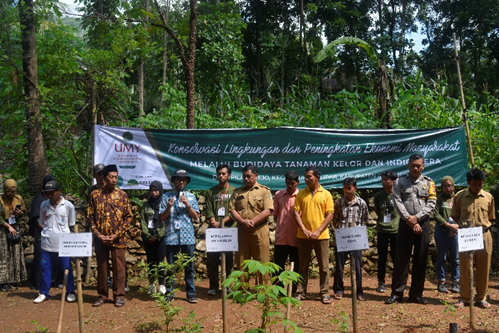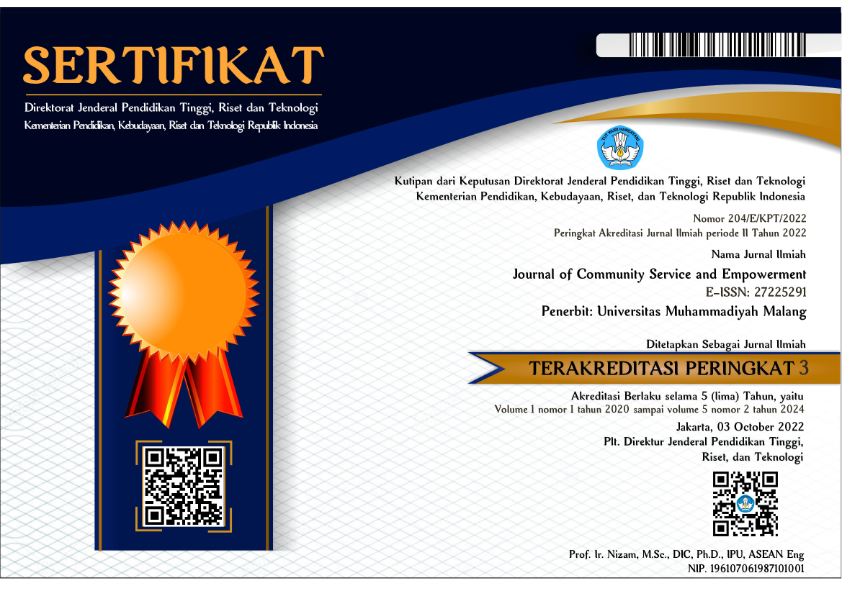Piloting moringa agribusiness to improve villagers’ economic community
DOI:
https://doi.org/10.22219/jcse.v2i3.16442Keywords:
Agribusiness, Moringa agriculture, Village economic communityAbstract
This activity was motivated by the low economic status of the village community, which is located far from the center of the district capital. On the other hand, there is potential for the development of kelor (Moringa) in the village. This community service was carried out with the aim of improving the community's economy through Moringa agribusiness in Pilangrejo Village, Nglipar District, Gunung Kidul Regency. This activity was carried out in January-June 2020, in Danyangan Hamlet, Pilangrejo Village, Nglipar District, Gunungkidul Regency. This activity was attended by the people of Danyangan Hamlet, both men and women. The male participants were those who make a living as farmers. While the female participants were housewives who do not have any permanent livelihood. The number of primary participants were 10 people who were community leaders in Pilangrejo Village. The implementation stages of activities include kelor planting and seedling, training on post-harvest processing, and providing production tool. The implementation of this activity is based on subsystems in agribusiness, namely the upstream (input) subsystem, on-farm subsystem and downstream subsystem. The results of this activity can be said that the piloting of Moringa agribusiness can be one solution that can be done in an effort to improve the economy of the community in Danyangan Hamlet, Pilangrejo Village, Gunung Kidul Regency. The benefits that can be obtained in this activity include the sale of Moringa powder and the use of Moringa as the main menu in the community's food pattern.
Downloads
References
Adhitya, F., Rusdiana, O., & Saleh, M. B. (2016). Penentuan Jenis Tumbuhan Lokasi dalam Upaya Mitigasi Longsor dan Teknik Budidayanya Pada Areal Rawan Longsor di KPH Lawu DS: Studi Kasus di RPH Cepoko. Jurnal Silvikultur Tropika, 8(1), 9–19.
Arulselvan, P., Fard, M. T., Tan, W. S., Gothai, S., Fakurazi, S., Norhaizan, M. E., & Kumar, S. S. (2016). Role of antioxidants and natural products in inflammation. Oxidative Medicine and Cellular Longevity, 2016. https://doi.org/10.1155/2016/5276130
Asah, S. T., & Blahna, D. J. (2013). Practical implications of understanding the influence of motivations on commitment to voluntary urban conservation stewardship. Conservation Biology, 27(4), 866–875. https://doi.org/10.1111/cobi.12058
Badan Pusat Statistik. (2020). Kecamatan Nglipar Dalam Angka 2019.
Badang Penanggulangan Bencana. (2012). Rencana Kontijensi Menghadapi Ancaman Bencana Tanah Longsor di Kecamatan Gedangsari, Nglipar dan Ngawen, Gunungkidul.
Calderon-Montano, J. M., Burgos-Moron, E., Perez-Guerrero, C., & Lopez-Lazaro, M. (2011). A review on the dietary flavonoid kaempferol. Mini-Reviews in Medicinal Chemistry, 11(4), 298–344. https://doi.org/10.2174/138955711795305335
Camacho, F. P., Sousa, V. S., Bergamasco, R., & Ribau Teixeira, M. (2017). The use of Moringa oleifera as a natural coagulant in surface water treatment. Chemical Engineering Journal, 313, 226–237. https://doi.org/10.1016/j.cej.2016.12.031
K.F. Omotesho, F.E. Sola-Ojo, T.R. Fayeye, & R.O. Babatunde. (2013). The potential of Moringa tree for poverty alleviation and rural development: Review of evidences on usage and efficacy. International Journal of Development and Sustainability, 2(2), 799–813.
Leone, A., Spada, A., Battezzati, A., Schiraldi, A., Aristil, J., & Bertoli, S. (2015). Cultivation, genetic, ethnopharmacology, phytochemistry and pharmacology of Moringa oleifera leaves: An overview. International Journal of Molecular Sciences, 16(6), 12791–12835. https://doi.org/10.3390/ijms160612791
Nurohmah, A. (2017). Kajian Resiko dan Mitigasi Bencana Longsor Lahan Di Kecamatan Nglipar, Kabupaten Gunung Kidul, Daerah Istimewa Yogyakarta. Jurnal Enersia Publika, I(2), 28–50.
O.Nyumba, T., Wilson, K., Derrick, C. J., & Mukherjee, N. (2018). The use of focus group discussion methodology: Insights from two decades of application in conservation. Methods in Ecology and Evolution, 9(1), 20–32. https://doi.org/10.1111/2041-210X.12860
Paramita, A., & Kristiana, D. L. (2013). Teknik focus group discussion dalam penelitian kualitatif. Buletin Penelitian Sistem Kesehatan, 16(2), 117–127. www.enolsatoe.org/content/view/15/33/
Polda DIY. (2017). Hujan Deras Mengakibatkan Bencana Banjir dan Longsor Di Wilayah Nglipar.
Putri, A. (2017). Bencana Tanah Longsor Ancam Rumah Warga Danyangan. Sorot Gunungkidul.
Rahman, M. M., Hassan, M. H., Kalam, M. A., Atabani, A. E., Memon, L. A., & Rahman, S. M. A. (2014). Performance and emission analysis of Jatropha curcas and Moringa oleifera methyl ester fuel blends in a multi-cylinder diesel engine. Journal of Cleaner Production, 65, 304–310. https://doi.org/10.1016/j.jclepro.2013.08.034
Rasoolimanesh, S. M., Jaafar, M., Ahmad, A. G., & Barghi, R. (2017). Community participation in World Heritage Site conservation and tourism development. Tourism Management, 58, 142–153. https://doi.org/10.1016/j.tourman.2016.10.016
Rathnayake, R. M. W. (2016). “Turtle watching”: A strategy for endangered marine turtle conservation through community participation in Sri Lanka. Ocean and Coastal Management, 119, 199–207. https://doi.org/10.1016/j.ocecoaman.2015.10.014
Rodríguez-izquierdo, E., Gavin, M. C., & Macedo-bravo, M. O. (2010). Barriers and triggers to community participation across different stages of conservation management. Environmental Conservation, 37(3), 239–249. https://doi.org/10.1017/S0376892910000500
Santoso, B. B., & Parwata, I. A. (2018). Biji dan teknologi benih kelor (Moringa oleifera Lam.). In Penerbit Arga Puji (1st ed., Vol. 7, Issue 2). Penerbit Arga Puji.
Sidik, F. (2015). Menggali Potensi Lokal Mewujudkan Kemandirian Desa. JKAP (Jurnal Kebijakan Dan Administrasi Publik), 19(2), 115. https://doi.org/10.22146/jkap.7962
Syarifuddin, N. A. (2017). Daun Kelor sebagai Pakan Ternak (1st ed., Issue April). UPT Unhas Press.
Wasonowati, C., Sulistyaningsih, E., Indradewa, D., & Kurniasih, B. (2018). Pertumbuhan bibit kelor (Moringa oleifera lamk ) dari biji dan stek dengan interval pemberian air yang berbeda. Seminar Nasional Peran Keanekaragaman Hayati Untuk Mendukung Indonesia Sebagai Lumbung Pangan Dunia”, 2(1), 175–181.
Wulandari, E., Ernah, & Supyandi, D. (2017). Penguatan kemampuan manajerial petani melalui pelatihan dan pendampingan pencatatan finansial usaha tani di Kabupaten Cianjur. Dhamakarya: Jurnal Aplikasi Ipteks Untuk Masyarakat, 6(3), 189–192.

Downloads
Published
How to Cite
Issue
Section
License
Copyright (c) 2021 Wijaya et al

This work is licensed under a Creative Commons Attribution-ShareAlike 4.0 International License.












